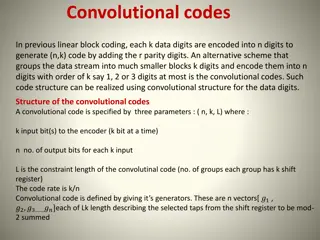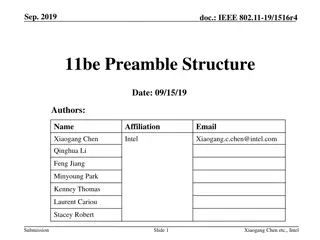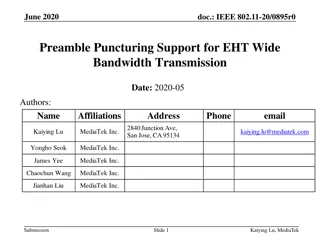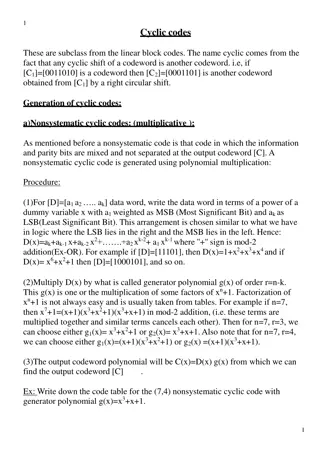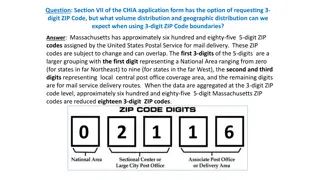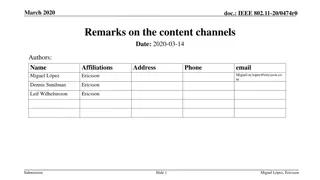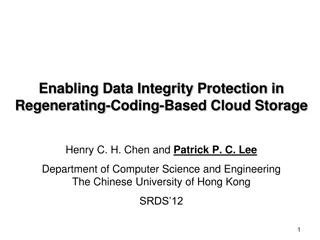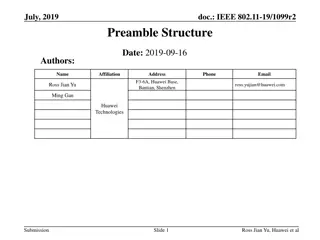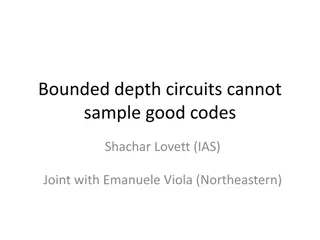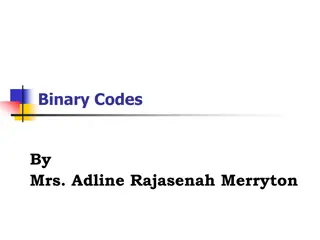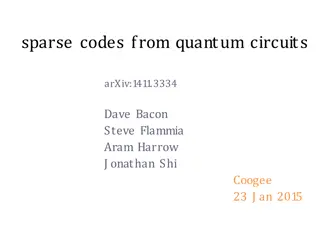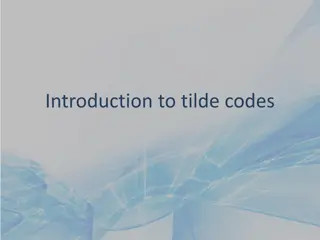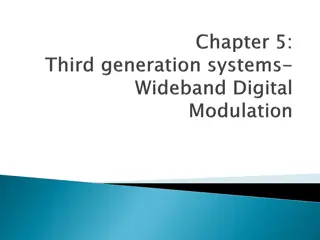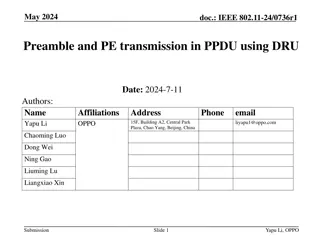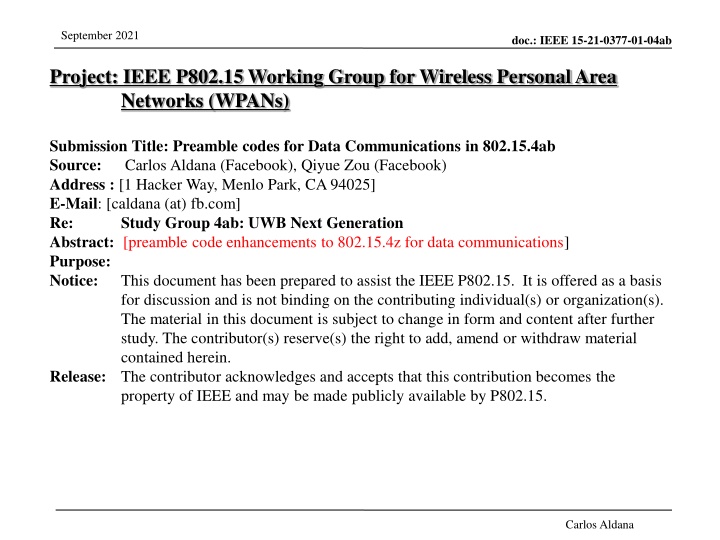
Enhancing Data Communications in IEEE 802.15.4ab with Preamble Codes
Explore the proposal for preamble code enhancements in IEEE 802.15.4ab to improve data communications, including safeguards for high throughput use cases, interference mitigation techniques, coexistence improvements, and more. The aim is to enhance link budget, reduce air-time, and increase accuracy and reliability for ranging applications. The proposed preamble codes aim to support various protocols and offer synchronization mechanisms for infrastructure deployment.
Download Presentation

Please find below an Image/Link to download the presentation.
The content on the website is provided AS IS for your information and personal use only. It may not be sold, licensed, or shared on other websites without obtaining consent from the author. If you encounter any issues during the download, it is possible that the publisher has removed the file from their server.
You are allowed to download the files provided on this website for personal or commercial use, subject to the condition that they are used lawfully. All files are the property of their respective owners.
The content on the website is provided AS IS for your information and personal use only. It may not be sold, licensed, or shared on other websites without obtaining consent from the author.
E N D
Presentation Transcript
September 2021 doc.: IEEE 15-21-0377-01-04ab Project: IEEE P802.15 Working Group for Wireless Personal Area Networks (WPANs) Submission Title: Preamble codes for Data Communications in 802.15.4ab Source: Carlos Aldana (Facebook), Qiyue Zou (Facebook) Address : [1 Hacker Way, Menlo Park, CA 94025] E-Mail: [caldana (at) fb.com] Re: Study Group 4ab: UWB Next Generation Abstract: [preamble code enhancements to 802.15.4z for data communications] Purpose: Notice: This document has been prepared to assist the IEEE P802.15. It is offered as a basis for discussion and is not binding on the contributing individual(s) or organization(s). The material in this document is subject to change in form and content after further study. The contributor(s) reserve(s) the right to add, amend or withdraw material contained herein. Release: The contributor acknowledges and accepts that this contribution becomes the property of IEEE and may be made publicly available by P802.15. Carlos Aldana
September 2021 doc.: IEEE 15-21-0377-01-04ab Technical Guidance [1] PAR Objective Safeguards so that the high throughput data use cases will not cause significant disruption to low duty-cycle ranging use cases. Proposed Solution (how addressed) Preambles shown to have good cross correlation properties with legacy devices. Interference mitigation techniques to support higher density and higher traffic use cases Other coexistence improvement Backward compatibility with enhanced ranging capable devices (ERDEVs). Improved link budget and/or reduced air-time Additional channels and operating frequencies Improvements to accuracy / precision / reliability and interoperability for high-integrity ranging; s Reduce complexity and power consumption; Hybrid operation with narrowband signaling to assist UWB; Enhanced native discovery and connection setup mechanisms; Sensing capabilities to support presence detection and environment mapping; Low-power low-latency streaming higher data-rate streaming allowing at least 50 Mbit/s of throughput. Support for peer-to-peer, peer-to-multi-peer, and station-to-infrastructure protocols; New preamble codes could be used for this use case. New preamble codes are proposed Infrastructure synchronization mechanisms. Carlos Aldana Slide 2
September 2021 doc.: IEEE 15-21-0377-01-04ab Preamble codes for Data Communications in 802.15.4ab Carlos Aldana
September 2021 doc.: IEEE 15-21-0377-01-04ab Objective Propose preamble codes (SYNC field) candidates for data communications over IEEE 802.15.4a UWB channels [2] Carlos Aldana
September 2021 doc.: IEEE 15-21-0377-01-04ab Background 4 configurations defined 802.15.4z[3] This contribution focuses on the SYNC field Carlos Aldana Slide 5
September 2021 doc.: IEEE 15-21-0377-01-04ab Key Considerations Excellent periodic autocorrelation properties -> improved ranging and channel estimation Good cross-correlation properties with HRP and LRP preambles -> coexist with legacy UWB devices Good periodic cross-correlation properties -> coexist with other data communication UWB devices Reduced SYNC field length -> reduced air time and improved PHY efficiency Carlos Aldana
September 2021 doc.: IEEE 15-21-0377-01-04ab Periodic Autocorrelation Good periodic autocorrelation makes channel estimation easy (via matched filter) Ternary preamble sequences (S1-S32) [4] specified in the UWB standards have perfect periodic autocorrelation function (i.e., out-of-phase autocorrelation = 0) Matched filter output is equal to the channel impulse response plus noise (assuming symbol length Tsym channel duration) IEEE 802.15.4a CM1 CM9 channel models defined in [2] have PDP channel duration in the range 80ns 850ns. All channel models except CM6 and CM8 have PDP duration < 400ns Length of Delta Spreading Function Preamble Code Length #Chips Per Symbol Preamble Code Tsym S1-S8 31 16 496 0.994us S1-S8 31 64 1984 3.974us S9 S24 127 4 508 1.018us S25 S32 91 4 364 0.729us Carlos Aldana
September 2021 doc.: IEEE 15-21-0377-01-04ab UWB Channel Model (CM1) CM1 channel model: residential, LOS PDP channel length = ~110ns Carlos Aldana
September 2021 doc.: IEEE 15-21-0377-01-04ab UWB Channel Model (CM2) CM2 channel model: residential, NLOS PDP channel length = ~210ns Carlos Aldana
September 2021 doc.: IEEE 15-21-0377-01-04ab UWB Channel Model (CM3) CM3 channel model: indoor office, LOS PDP channel length = ~95ns Carlos Aldana
September 2021 doc.: IEEE 15-21-0377-01-04ab UWB Channel Model (CM4) CM4 channel model: indoor office, NLOS PDP channel length = ~115ns Carlos Aldana
September 2021 doc.: IEEE 15-21-0377-01-04ab UWB Channel Model (CM5) CM5 channel model: outdoor, LOS PDP channel length = ~200ns Carlos Aldana
September 2021 doc.: IEEE 15-21-0377-01-04ab UWB Channel Model (CM6) CM6 channel model: outdoor, NLOS PDP channel length = ~800ns Carlos Aldana
September 2021 doc.: IEEE 15-21-0377-01-04ab UWB Channel Model (CM7) CM7 channel model: industrial, LOS PDP channel length = ~80ns Carlos Aldana
September 2021 doc.: IEEE 15-21-0377-01-04ab UWB Channel Model (CM8) CM8 channel model: industrial, NLOS PDP channel length = ~850ns Carlos Aldana
September 2021 doc.: IEEE 15-21-0377-01-04ab UWB Channel Model (CM9) CM9 channel model: farm PDP channel length = ~400ns Carlos Aldana
September 2021 doc.: IEEE 15-21-0377-01-04ab Periodic Autocorrelation m-sequences have quasi-optimal periodic autocorrelation quasi-optimal -> Out-of-phase autocorrelation = -1 while autocorrelation peak = N Although not perfect , N can be chosen such that N/1 is large and does not degrade system performance significantly, e.g., 20*log10(N/1) 20dB m-sequences are bipolar, where only +1 and -1 are transmitted Number of 1s = Number of 0s + 1 More pulses are transmitted compared to equal length ternary sequences For example, S1 S8 (length = 31) - each sequence has 15 0 s S9 S24 (length = 127) - each sequence has 63 0 s S25 S32 (length = 91) - each sequence has 10 0 s Carlos Aldana
September 2021 doc.: IEEE 15-21-0377-01-04ab S9 Length 127 sequence vs Length 63 m-sequence m-sequence of length 63 M- sequence of length 63 ternary preamble sequence S9 Ternary preamble sequence S9n Carlos Aldana
September 2021 doc.: IEEE 15-21-0377-01-04ab Implementation m-sequences are generated using linear-feedback shift registers (LFSR), and have low implementation cost and complexity A 10-bit LFSR with feedback polynomial 0x291(Hex) = 10 b 10 1001 0001 0x291 = 1 0 1 0 0 1 0 0 0 1 An n-bit LFSR generates a m-sequence of length 2n-1 LFSR is determined by the feedback polynomial Carlos Aldana Slide 19
September 2021 doc.: IEEE 15-21-0377-01-04ab Periodic Cross-Correlation Periodic cross-correlation between different proposed sequences should be small in order to limit the interference within a piconet Goal is to maximize Sidelobe Suppression Ratio (SSR) autocorrelation peak average cross correlation peak) = 20log10( Carlos Aldana
September 2021 doc.: IEEE 15-21-0377-01-04ab Periodic Cross-Correlation of S25 (Length 91) Maximum Sidelobe Suppression Ratio = 20log10(81/15) = 14.65dB Minimum Sidelobe Suppression Ratio = 20log10(81/27) = 9.54dB Average Sidelobe Suppression Ratio = 20*log10(81/21.43) = 11.55dB Consistent with Table in [5] Carlos Aldana
September 2021 doc.: IEEE 15-21-0377-01-04ab Periodic Cross-Correlation of m-sequences of length 63 Maximum Sidelobe Suppression Ratio = 20log10(63/15) = 12.47dB Minimum Sidelobe Suppression Ratio = 20log10(63/23) = 8.75dB Average Sidelobe Suppression Ratio = 20*log10(63/19) = 10.41dB Carlos Aldana
September 2021 doc.: IEEE 15-21-0377-01-04ab Cross-Correlation with HRP and LRP Preambles Cross-correlation between proposed sequences and legacy HRP and LRP preambles needs to be small Binary m-sequences have length 2m -1, e.g.,15, 31, 63, 127, 255, m-sequences of length 31 and 127 have relatively large cross-correlation with length-31 and length-127 legacy preamble sequences (i.e., S1-S8, S9-S24) m-sequences are robust to LRP preambles (see subsequent slides) m-sequences of length 15 does not provide enough rejection. Therefore, m-sequences of length 63, 255, 511, 1023, are considered Carlos Aldana
September 2021 doc.: IEEE 15-21-0377-01-04ab Shorter Sync Length for Existing Codes sync_length = Tsym Nsync = Tc K L Nsync K L Sync Length (Nsync = 16 Symbols) Sync Length (Nsync = 64 Symbols) (preamble code length) (length of delta spreading function) #Chips Per Symbol Tsym 31 16 496 0.994us 15.897us 63.590us 31 64 1984 3.974us 63.590us 254.359us 127 4 508 1.018us 16.282us 65.128us 91 4 364 0.729us 11.667us 46.667us Carlos Aldana
September 2021 Sync Length for Short Preamble doc.: IEEE 15-21-0377-01-04ab Short preamble length less than 33us reduces PPDU duration Smaller Nsync for LOS short-distance channels Nsync 16 for HRP UWB preambles Nsync = 4 or 8 can work for short-distance LOS channels To reduce sync length, smaller L for long sequences For long sequences, e.g., m-sequences of length 255 or 511, the delta spreading length L can be 1 or 2 L K Sync Length (Nsync = 4 Symbols) Sync Length (Nsync = 8 Symbols) Sync Length (Nsync = 16 Symbols) (length of delta spreading function) #Chips Per Symbol (preamble code length) Tsym 63 8 504 1.010us 4.038us 8.077us 16.154us 255 1 255 0.511us 2.043us 4.087us 8.173us 255 2 510 1.022us 4.087us 8.173us 16.346us 511 1 511 1.024us 4.095us 8.189us 16.378us 511 2 1022 2.047us 8.189us 16.378us 32.756us Carlos Aldana
September 2021 doc.: IEEE 15-21-0377-01-04ab Spectrum Characteristics of Existing UWB Preambles L K SPAR (frequency domain) Preamble Code (length of delta spreading function #Chips Per Symbol (preamble code length) Tsym S1 S8 31 16 496 0.994us 0.4dB S1 S8 31 64 1984 3.974us 0.4dB S9 S24 127 4 508 1.018us 0.5dB S25 S32 91 4 364 0.729us 0.9dB Carlos Aldana
September 2021 doc.: IEEE 15-21-0377-01-04ab Spectrum Characteristics of m- sequences L Delta Peak EIRP over peak EIRP of preamble code 9 with L = 4 (dB) K (length of delta spreadi ng function ) Sync Length (Nsync = 16 Symbols ) Delta SPAR over SPAR of preamble code 9 with L = 4 (dB) Sync Length (Nsync = 8 Symbols) #Chips Per Symbol Sync Length (Nsync = 4 Symbols) SPAR (frequency domain) (preamb le code length) Tsym 63 8 504 1.010us 4.038us 8.077us 16.154us 0.5dB -3.5dB 0dB 255 2 510 1.022us 4.087us 8.173us 16.346us 0.5dB 0dB 0dB 255 4 1020 2.043us 8.173us 16.346us 32.692us 0.4dB -3.0dB -0.1dB 511 1 511 1.024us 4.095us 8.189us 16.378us 0.5dB +2.6dB 0dB 511 2 1022 2.047us 8.189us 16.378us 32.756us 0.4dB 0dB -0.1dB 1023 1 1023 2.049us 8.197us 16.394us 32.789us 0.4dB +2.9dB -0.1dB 1023 2 2046 4.099us 16.394us 32.789us 65.577us 0.4dB +0.1dB -0.1dB 2047 1 2027 4.101us 16.402us 32.805us 65.609us 0.4dB +3.0dB -0.1dB 2047 2 4094 8.201us 32.805us 65.609us 131.218us 0.4dB +0.1dB -0.1dB Carlos Aldana
September 2021 doc.: IEEE 15-21-0377-01-04ab M-Sequences of Length 63 Code Index Feedback Polynomial Code Sequence -1,-1,-1,-1,-1,1,1,1,1,1,1,-1,1,-1,1,-1,1,1,-1,-1,1,1,-1,1,1,1,-1,1,1,-1,1,-1,-1,1,-1,-1,1,1,1,-1,-1,-1,1,- 1,1,1,1,1,-1,-1,1,-1,1,-1,-1,-1,1,1,-1,-1,-1,-1,1 M63_1 21 -1,-1,-1,-1,-1,1,-1,-1,-1,-1,1,1,-1,-1,-1,1,-1,1,-1,-1,1,1,1,1,-1,1,-1,-1,-1,1,1,1,-1,-1,1,-1,-1,1,-1,1,1,- 1,1,1,1,-1,1,1,-1,-1,1,1,-1,1,-1,1,-1,1,1,1,1,1,1 M63_2 30 -1,-1,-1,-1,-1,1,1,1,-1,-1,-1,-1,1,-1,-1,1,-1,-1,-1,1,1,-1,1,1,-1,-1,1,-1,1,1,-1,1,-1,1,1,1,-1,1,1,1,1,-1,- 1,1,1,-1,-1,-1,1,-1,1,-1,1,-1,-1,1,1,1,1,1,1,-1,1 M63_3 2D -1,-1,-1,-1,-1,1,-1,1,1,1,1,1,1,-1,-1,1,-1,1,-1,1,-1,-1,-1,1,1,-1,-1,1,1,1,1,-1,1,1,1,-1,1,-1,1,1,-1,1,-1,- 1,1,1,-1,1,1,-1,-1,-1,1,-1,-1,1,-1,-1,-1,-1,1,1,1 M63_4 36 M63_1 1 15 17 23 M63_2 15 1 23 17 M63_3 17 23 1 15 M63_4 23 17 15 1 M63_1 35.99 12.46 11.38 8.75 M63_2 12.46 35.99 8.75 11.38 M63_3 11.38 8.75 35.99 12.46 M63_4 8.75 11.38 12.46 35.99 M63_1 M63_2 M63_3 M63_4 M63_1 M63_2 M63_3 M63_4 Cross-correlation Sidelobe Peak Value Sidelobe Suppression Ratio (dB) = 20log10(autocorrelation peak / cross-correlation peak) Carlos Aldana
September 2021 doc.: IEEE 15-21-0377-01-04ab M-Sequences of Length 255 M255_1 M255_2 M255_3 M255_4 M255_5 M255_6 M255_7 M255_8 Code Index 95 AF A6 F3 B4 B8 C6 E1 Feedback Polynomial M255_1 1 31 63 63 63 47 31 47 M255_2 31 1 63 63 47 31 47 63 M255_3 63 63 1 31 31 47 63 47 M255_4 63 63 31 1 47 63 47 31 M255_5 63 47 31 47 1 31 63 63 M255_6 47 31 47 63 31 1 63 63 M255_7 31 47 63 47 63 63 1 31 M255_8 47 63 47 31 63 63 31 1 M255_1 M255_2 M255_3 M255_4 M255_5 M255_6 M255_7 M255_8 Cross-correlation Sidelobe Peak Value M255_1 48.13 18.3 12.14 12.14 12.14 14.69 18.3 14.69 M255_2 18.3 48.13 12.14 12.14 14.69 18.3 14.69 12.14 M255_3 12.14 12.14 48.13 18.3 18.3 14.69 12.14 14.69 M255_4 12.14 12.14 18.3 48.13 14.69 12.14 14.69 18.3 M255_5 12.14 14.69 18.3 14.69 48.13 18.3 12.14 12.14 M255_6 14.69 18.3 14.69 12.14 18.3 48.13 12.14 12.14 M255_7 18.3 14.69 12.14 14.69 12.14 12.14 48.13 18.3 M255_8 14.69 12.14 14.69 18.3 12.14 12.14 18.3 48.13 M255_1 M255_2 M255_3 M255_4 M255_5 M255_6 M255_7 M255_8 Sidelobe Suppression Ratio (dB) Carlos Aldana
September 2021 doc.: IEEE 15-21-0377-01-04ab M-Sequences of Length 511 M511_1 M511_2 M511_3 M511_4 M511_5 M511_6 M511_7 M511_8 Code Index 143 15E 17A 1C2 167 1E5 1A7 1E6 Feedback Polynomial M511_1 1 33 55 45 33 65 49 63 M511_2 33 1 45 55 73 33 63 33 M511_3 55 45 1 33 33 63 33 73 M511_4 45 55 33 1 63 49 65 33 M511_5 33 73 33 63 1 33 55 45 M511_6 65 33 63 49 33 1 45 55 M511_7 49 63 33 65 55 45 1 33 M511_8 63 33 73 33 45 55 33 1 M511_1 M511_2 M511_3 M511_4 M511_5 M511_6 M511_7 M511_8 Cross-correlation Sidelobe Peak Value M511_1 54.17 23.8 19.36 21.1 23.8 17.91 20.36 18.18 M511_2 23.8 54.17 21.1 19.36 16.9 23.8 18.18 23.8 M511_3 19.36 21.1 54.17 23.8 23.8 18.18 23.8 16.9 M511_4 21.1 19.36 23.8 54.17 18.18 20.36 17.91 23.8 M511_5 23.8 16.9 23.8 18.18 54.17 23.8 19.36 21.1 M511_6 17.91 23.8 18.18 20.36 23.8 54.17 21.1 19.36 M511_7 20.36 18.18 23.8 17.91 19.36 21.1 54.17 23.8 M511_8 18.18 23.8 16.9 23.8 21.1 19.36 23.8 54.17 M511_1 M511_2 M511_3 M511_4 M511_5 M511_6 M511_7 M511_8 Sidelobe Suppression Ratio (dB) Carlos Aldana
September 2021 doc.: IEEE 15-21-0377-01-04ab M-Sequences of Length 1023 M1023_1 M1023_2 M1023_3 M1023_4 M1023_5 M1023_6 M1023_7 M1023_8 Code Index 204 240 291 312 237 3D8 262 28C Feedback Polynomial M1023_1 M1023_2 M1023_3 M1023_4 M1023_5 M1023_6 M1023_7 M1023_8 1 63 65 81 63 1 81 65 65 81 1 63 81 65 63 1 65 95 97 97 95 65 97 97 97 97 127 97 97 97 97 127 M1023_1 M1023_2 M1023_3 M1023_4 M1023_5 M1023_6 M1023_7 M1023_8 65 95 97 97 1 63 81 65 95 65 97 97 63 1 65 81 97 97 127 97 81 65 1 63 97 97 97 127 65 81 63 1 Cross-correlation Sidelobe Peak Value M1023_1 M1023_2 M1023_3 M1023_4 M1023_5 M1023_6 M1023_7 M1023_8 60.2 24.21 23.94 22.03 24.21 60.2 22.03 23.94 23.94 22.03 60.2 24.21 22.03 23.94 24.21 60.2 23.94 20.64 20.46 20.46 20.64 23.94 20.46 20.46 20.46 20.46 18.12 20.46 20.46 20.46 20.46 18.12 M1023_1 M1023_2 M1023_3 M1023_4 M1023_5 M1023_6 M1023_7 M1023_8 23.94 20.64 20.46 20.46 60.2 24.21 22.03 23.94 20.64 23.94 20.46 20.46 24.21 60.2 23.94 22.03 20.46 20.46 18.12 20.46 22.03 23.94 60.2 24.21 20.46 20.46 20.46 18.12 23.94 22.03 24.21 60.2 Sidelobe Suppression Ratio (dB) Carlos Aldana
September 2021 doc.: IEEE 15-21-0377-01-04ab M-Sequences of Length 2047 M2047_1 M2047_2 M2047_3 M2047_4 M2047_5 M2047_6 M2047_7 M2047_8 Code Index 40B 56A 5E4 767 416 44A 4FB 67B Feedback Polynomial M2047_1 M2047_2 M2047_3 M2047_4 M2047_5 M2047_6 M2047_7 M2047_8 1 65 65 65 65 1 65 65 65 65 1 65 65 65 65 1 65 65 129 127 65 129 65 113 129 113 127 129 129 65 65 129 M2047_1 M2047_2 M2047_3 M2047_4 M2047_5 M2047_6 M2047_7 M2047_8 65 65 129 127 1 65 65 65 65 129 65 113 65 1 65 65 129 113 127 129 65 65 1 65 129 65 65 129 65 65 65 1 Cross-correlation Sidelobe Peak Value M2047_1 M2047_2 M2047_3 M2047_4 M2047_5 M2047_6 M2047_7 M2047_8 66.22 29.96 29.96 29.96 29.96 66.22 29.96 29.96 29.96 29.96 66.22 29.96 29.96 29.96 29.96 66.22 29.96 29.96 24.01 24.15 29.96 24.01 29.96 25.16 24.01 25.16 24.15 24.01 24.01 29.96 29.96 24.01 M2047_1 M2047_2 M2047_3 M2047_4 M2047_5 M2047_6 M2047_7 M2047_8 29.96 29.96 24.01 24.15 66.22 29.96 29.96 29.96 29.96 24.01 29.96 25.16 29.96 66.22 29.96 29.96 24.01 25.16 24.15 24.01 29.96 29.96 66.22 29.96 24.01 29.96 29.96 24.01 29.96 29.96 29.96 66.22 Sidelobe Suppression Ratio (dB) Carlos Aldana
September 2021 doc.: IEEE 15-21-0377-01-04ab Cross-Correlation with HRP Preambles M1023_1 - M1023_8 (L = 1) M1023_1 - M1023_8 (L = 2) M2047_1 - M2047_8 (L = 1) M2047_1 - M2047_8 (L = 2) Tx Rx M63_1 - M63_8 (L = 8) M255_1 - M255_8 (L = 1) M255_1 - M255_8 (L = 2) M255_1 - M255_8 (L = 4) M511_1 - M511_8 (L = 1) M511_1 - M511_8 (L = 2) S3 - S4 (L = 16) (length = 31, channels 2, 5, 9, 13) S3 - S4 (L = 64) (length = 31, channels 2, 5, 9, 13) S9 - S12 (length = 127, channels 0-3, 5, 6, 8-10, 12- 14) Max = 25.75 dB Min = 22.92 dB Average = 23.88 dB Max = 32.20 dB Min = 28.76 dB Average = 30.37 dB Max = 29.19 dB Min = 25.75 dB Average = 27.41 dB Max = 26.43 dB Min = 22.74 dB Average = 24.52 dB Max = 30.82 dB Min = 27.81 dB Average = 29.71 dB Max = 28.03 dB Min = 24.80 dB Average = 26.73 dB Max = 31.48 dB Min = 28.43 dB Average = 29.54 dB Max = 28.47 dB Min = 25.42 dB Average = 26.58 dB Max = 29.82 dB Min = 27.81 dB Average = 28.72 dB Max = 26.81 dB Min = 24.80 dB Average = 25.70 dB Max = 30.82 dB Min = 29.19 dB Average = 29.73 dB Max = 40.16 dB Min = 35.66 dB Average = 37.79 dB Max = 34.72 dB Min = 31.77 dB Average = 33.24 dB Max = 32.20 dB Min = 28.76 dB Average = 30.37 dB Max = 36.84 dB Min = 33.68 dB Average = 35.51 dB Max = 33.83 dB Min = 30.82 dB Average = 32.53 dB Max = 37.06 dB Min = 33.98 dB Average = 35.38 dB Max = 34.05 dB Min = 30.97 dB Average = 32.45 dB Max = 35.47 dB Min = 33.83 dB Average = 34.62 dB Max = 32.83 dB Min = 30.67 dB Average = 31.56 dB Max = 27.30 dB Min = 22.67 dB Average = 25.01 dB Max = 31.94 dB Min = 26.47 dB Average = 29.89 dB Max = 29.05 dB Min = 23.85 dB Average = 27.00 dB Max = 26.04 dB Min = 20.84 dB Average = 24.03 dB Max = 31.59 dB Min = 26.86 dB Average = 29.62 dB Max = 28.58 dB Min = 23.91 dB Average = 26.69 dB Max = 30.72 dB Min = 27.26 dB Average = 29.00 dB Max = 27.71 dB Min = 24.32 dB Average = 26.07 dB Max = 29.74 dB Min = 26.28 dB Average = 28.28 dB Max = 26.92 dB Min = 23.27 dB Average = 25.33 dB Max = 25.60 dB Min = 21.91 dB Average = 24.23 dB Max = 30.50 dB Min = 26.70 dB Average = 28.76 dB Max = 27.71 dB Min = 23.76 dB Average = 25.86 dB Max = 24.59 dB Min = 20.75 dB Average = 22.89 dB Max = 29.79 dB Min = 25.08 dB Average = 27.72 dB Max = 26.88 dB Min = 22.02 dB Average = 24.81 dB Max = 29.32 dB Min = 25.14 dB Average = 27.48 dB Max = 26.88 dB Min = 22.13 dB Average = 24.51 dB Max = 28.95 dB Min = 25.49 dB Average = 27.17 dB Max = 25.94 dB Min = 22.30 dB Average = 24.22 dB S25 - S32 (length = 91) Carlos Aldana Slide 33
September 2021 doc.: IEEE 15-21-0377-01-04ab S3 - S4 (L = 16) (length = 31, channels 2, 5, 9, 13) S3 - S4 (L = 64) (length = 31, channels 2, 5, 9, 13) S9 - S12 (length = 127, channels 0-3, 5, 6, 8-10, 12-14) Tx Rx S25 - S32 (length = 91) Max = 25.89 dB Min = 23.06 dB Average = 23.98 dB Max = 22.59 dB Min = 18.92 dB Average = 21.12 dB Max = 27.43 dB Min = 22.60 dB Average = 24.98 dB Max = 26.32 dB Min = 22.75 dB Average = 24.75 dB M63_1 - M63_8 (L = 8) M255_1 - M255_8 (L = 1) Max = 28.36 dB Min = 24.43 dB Average = 26.31 dB Max = 27.20 dB Min = 24.83 dB Average = 25.85 dB Max = 28.25 dB Min = 23.39 dB Average = 26.40 dB Max = 28.79 dB Min = 25.18 dB Average = 26.80 dB M255_1 - M255_8 (L = 2) Max = 29.18 dB Min = 25.19 dB Average = 27.49 dB Max = 27.05 dB Min = 23.66 dB Average = 25.95 dB Max = 29.08 dB Min = 23.82 dB Average = 26.98 dB Max = 29.81 dB Min = 24.89 dB Average = 27.61 dB M255_1 - M255_8 (L = 4) Max = 29.88 dB Min = 26.67 dB Average = 28.48 dB Max = 28.36 dB Min = 24.43 dB Average = 26.31 dB Max = 29.68 dB Min = 24.99 dB Average = 27.85 dB Max = 30.49 dB Min = 26.09 dB Average = 28.51 dB M511_1 - M511_8 (L = 1) M511_1 - M511_8 (L = 2) Max = 30.87 dB Min = 27.92 dB Average = 29.86 dB Max = 32.20 dB Min = 28.62 dB Average = 30.21 dB Max = 30.08 dB Min = 27.49 dB Average = 29.06 dB Max = 30.50 dB Min = 27.66 dB Average = 29.38 dB Max = 31.52 dB Min = 26.78 dB Average = 29.60 dB Max = 32.26 dB Min = 26.74 dB Average = 30.13 dB Max = 31.81 dB Min = 26.67 dB Average = 29.41 dB Max = 31.87 dB Min = 27.65 dB Average = 29.92 dB M1023_1 - M1023_8 (L = 1) Max = 35.74 dB Min = 32.98 dB Average = 34.32 dB Max = 32.22 dB Min = 30.28 dB Average = 31.47 dB Max = 33.92 dB Min = 30.37 dB Average = 32.70 dB Max = 34.23 dB Min = 30.63 dB Average = 32.77 dB M1023_1 - M1023_8 (L = 2) Max = 34.42 dB Min = 31.47 dB Average = 33.06 dB Max = 34.31 dB Min = 31.24 dB Average = 32.69 dB Max = 35.01 dB Min = 30.65 dB Average = 33.50 dB Max = 36.36 dB Min = 33.12 dB Average = 34.59 dB M2047_1 - M2047_8 (L = 1) Max = 37.11 dB Min = 34.41 dB Average = 35.78 dB Max = 35.75 dB Min = 33.95 dB Average = 34.74 dB Max = 37.28 dB Min = 31.71 dB Average = 35.53 dB Max = 38.20 dB Min = 34.96 dB Average = 36.72 dB M2047_1 - M2047_8 (L = 2) Max = 40.13 dB Min = 37.42 dB Average = 38.75 dB Max = 36.53 dB Min = 34.10 dB Average = 35.15 dB Max = 40.46 dB Min = 35.13 dB Average = 38.54 dB Max = 41.31 dB Min = 38.23 dB Average = 39.80 dB Carlos Aldana Slide 34
September 2021 doc.: IEEE 15-21-0377-01-04ab Cross-Correlation with LRP Preambles LPR preambles are a continuous stream of pulses Mode Modulation PRF (MHz) SHR 16 - 128 pulse (non- ERDEV); 16 256 pulses (ERDEV) Base Mode OOK 1.0 PBFSK 1.0 Dual-frequency modes PBFSK 2.0 16 256 pulses PBFSK 4.0 Carlos Aldana Slide 35
September 2021 doc.: IEEE 15-21-0377-01-04ab Cross-Correlation with LRP Preambles Channel Band Number ERIP HRP 9 Mean EIRP = -14.3dBm LRP 2 (center freq. identical to HRP channel 9) Peak EIRP = 12dBm Correlation between HRP preambles and LRP preambles S3 - S4 (L = 16) (length = 31, channels 2, 5, 9, 13) S3 - S4 (L = 64) (length = 31, channels 2, 5, 9, 13) S9 - S12 (length = 127, channels 0-3, 5, 6, 8-10, 12-14) LRP UWB Base Mode (PRF = 1MHz) LRP UWB Dual Frequency Mode (PRF = 1MHz) LRP UWB Dual Frequency Mode (PRF = 2MHz) LRP UWB Dual Frequency Mode (PRF = 4MHz) Tx Rx Tx Rx S25 - S32 (length = 91) S3 - S4 (L = 16) (length = 31, channels 2, 5, 9, 13) Max = 21.55 dB Min = 19.04 dB Average = 20.21 dB Max = 22.66 dB Min = 20.38 dB Average = 21.45 dB Max = 20.17 dB Min = 19.03 dB Average = 19.58 dB Max = 17.07 dB Min = 16.54 dB Average = 16.80 dB LRP UWB Base Mode (PRF = 1MHz) Max = 40.30 dB Min = 37.78 dB Average = 38.95 dB Max = 34.41 dB Min = 31.89 dB Average = 33.06 dB Max = 44.06 dB Min = 43.09 dB Average = 43.50 dB Max = 44.96 dB Min = 43.66 dB Average = 44.49 dB S3 - S4 (L = 64) (length = 31, channels 2, 5, 9, 13) S9 - S12 (length = 127, channels 0-3, 5, 6, 8-10, 12- 14) LRP UWB Dual Frequency Mode (PRF = 1MHz) Max = 23.27 dB Min = 21.70 dB Average = 22.45 dB Max = 23.26 dB Min = 22.72 dB Average = 22.99 dB Max = 23.26 dB Min = 21.69 dB Average = 22.44 dB Max = 23.23 dB Min = 21.70 dB Average = 22.43 dB Max = 41.41 dB Min = 39.09 dB Average = 40.17 dB Max = 35.35 dB Min = 33.04 dB Average = 34.12 dB Max = 46.20 dB Min = 44.57 dB Average = 45.23 dB Max = 46.49 dB Min = 45.45 dB Average = 45.95 dB LRP UWB Dual Frequency Mode (PRF = 2MHz) Max = 24.96 dB Min = 23.56 dB Average = 24.32 dB Max = 27.22 dB Min = 25.94 dB Average = 26.37 dB Max = 23.43 dB Min = 22.90 dB Average = 23.13 dB Max = 21.83 dB Min = 19.02 dB Average = 20.36 dB Max = 41.25 dB Min = 38.96 dB Average = 40.03 dB Max = 37.83 dB Min = 37.82 dB Average = 37.82 dB Max = 45.62 dB Min = 43.87 dB Average = 44.67 dB Max = 46.33 dB Min = 45.44 dB Average = 45.93 dB LRP UWB Dual Frequency Mode (PRF = 4MHz) Max = 24.54 dB Min = 23.04 dB Average = 23.56 dB Max = 25.73 dB Min = 24.10 dB Average = 24.96 dB Max = 22.80 dB Min = 21.68 dB Average = 22.26 dB Max = 20.74 dB Min = 19.67 dB Average = 20.28 dB Max = 41.23 dB Min = 38.99 dB Average = 40.04 dB Max = 43.73 dB Min = 43.73 dB Average = 43.73 dB Max = 45.76 dB Min = 44.18 dB Average = 45.15 dB Max = 46.61 dB Min = 44.88 dB Average = 45.67 dB S25 - S32 (length = 91) Carlos Aldana Slide 36
September 2021 doc.: IEEE 15-21-0377-01-04ab LRP UWB Base Mode (PRF = 1MHz) LRP UWB Dual Frequency Mode (PRF = 1MHz) LRP UWB Dual Frequency Mode (PRF = 2MHz) LRP UWB Dual Frequency Mode (PRF = 4MHz) Tx Rx Max = 24.53 dB Min = 24.48 dB Average = 24.50 dB Max = 25.87 dB Min = 25.66 dB Average = 25.77 dB Max = 21.12 dB Min = 21.09 dB Average = 21.10 dB Max = 18.15 dB Min = 18.08 dB Average = 18.12 dB M63_1 - M63_4 (L=8) Max = 22.77 dB Min = 21.72 dB Average = 22.33 dB Max = 24.22 dB Min = 21.99 dB Average = 23.05 dB Max = 21.71 dB Min = 20.13 dB Average = 20.74 dB Max = 17.87 dB Min = 15.57 dB Average = 17.13 dB M255_1 - M255_8 (L=1) Correlation between m- sequences and LRP preambles are not worse than HRP preambles Max = 25.11 dB Min = 24.10 dB Average = 24.54 dB Max = 26.59 dB Min = 24.88 dB Average = 25.69 dB Max = 23.82 dB Min = 21.16 dB Average = 22.56 dB Max = 21.55 dB Min = 18.98 dB Average = 20.61 dB M255_1 - M255_8 (L=2) Max = 28.80 dB Min = 27.37 dB Average = 28.06 dB Max = 29.23 dB Min = 28.29 dB Average = 28.63 dB Max = 27.22 dB Min = 25.31 dB Average = 26.28 dB Max = 23.63 dB Min = 22.07 dB Average = 22.79 dB M255_1 - M255_8 (L=4) Max = 24.99 dB Min = 22.96 dB Average = 24.10 dB Max = 26.27 dB Min = 25.17 dB Average = 25.60 dB Max = 24.62 dB Min = 22.58 dB Average = 23.31 dB Max = 21.12 dB Min = 19.46 dB Average = 20.28 dB M511_1 - M511_8 (L=1) Max = 28.10 dB Min = 25.48 dB Average = 27.06 dB Max = 29.34 dB Min = 27.45 dB Average = 28.62 dB Max = 26.41 dB Min = 24.65 dB Average = 25.83 dB Max = 24.83 dB Min = 22.28 dB Average = 23.79 dB M511_1 - M511_8 (L=2) M1023_1 - M1023_8 (L=1) Max = 27.75 dB Min = 25.60 dB Average = 26.94 dB Max = 29.59 dB Min = 26.76 dB Average = 28.47 dB Max = 26.62 dB Min = 23.63 dB Average = 25.53 dB Max = 24.37 dB Min = 22.69 dB Average = 23.69 dB M1023_1 - M1023_8 (L=2) Max = 30.96 dB Min = 28.80 dB Average = 29.86 dB Max = 32.19 dB Min = 30.58 dB Average = 31.60 dB Max = 29.58 dB Min = 28.15 dB Average = 28.87 dB Max = 27.27 dB Min = 26.27 dB Average = 26.78 dB M2047_1 - M2047_8 (L=1) Max = 31.84 dB Min = 29.16 dB Average = 30.73 dB Max = 32.87 dB Min = 30.45 dB Average = 31.54 dB Max = 29.56 dB Min = 26.71 dB Average = 28.38 dB Max = 28.28 dB Min = 25.69 dB Average = 27.00 dB M2047_1 - M2047_8 (L=2) Max = 34.63 dB Min = 31.63 dB Average = 33.14 dB Max = 35.15 dB Min = 32.97 dB Average = 34.20 dB Max = 33.20 dB Min = 30.91 dB Average = 31.69 dB Max = 32.14 dB Min = 31.20 dB Average = 31.69 dB Carlos Aldana Slide 37
September 2021 doc.: IEEE 15-21-0377-01-04ab Transmit m sequences and receive LRP Tx Rx M63_1 - M63_4 (L=8) M255_1 - M255_8 (L=1) M255_1 - M255_8 (L=2) M255_1 - M255_8 (L=4) M511_1 - M511_8 (L=1) M511_1 - M511_8 (L=2) M1023_1 - M1023_8 (L=1) M1023_1 - M1023_8 (L=2) M2047_1 - M2047_8 (L=1) M2047_1 - M2047_8 (L=2) LRP UWB Base Mode (PRF = 1MHz) Max = 43.56 dB Min = 43.47 dB Average = 43.51 dB Max = 45.11 dB Min = 43.37 dB Average = 44.22 dB Max = 44.04 dB Min = 42.75 dB Average = 43.30 dB Max = 44.74 dB Min = 43.80 dB Average = 44.38 dB Max = 43.67 dB Min = 42.61 dB Average = 43.24 dB Max = 43.60 dB Min = 42.10 dB Average = 42.82 dB Max = 43.41 dB Min = 41.48 dB Average = 42.49 dB Max = 42.85 dB Min = 42.31 dB Average = 42.58 dB Max = 43.42 dB Min = 42.09 dB Average = 42.81 dB Max = 43.28 dB Min = 42.27 dB Average = 42.76 dB LRP UWB Dual Frequency Mode (PRF = 1MHz) LRP UWB Dual Frequency Mode (PRF = 2MHz) LRP UWB Dual Frequency Mode (PRF = 4MHz) Max = 44.75 dB Min = 44.72 dB Average = 44.74 dB Max = 46.42 dB Min = 43.36 dB Average = 44.59 dB Max = 45.40 dB Min = 44.05 dB Average = 44.68 dB Max = 45.94 dB Min = 45.08 dB Average = 45.54 dB Max = 45.24 dB Min = 43.86 dB Average = 44.36 dB Max = 45.62 dB Min = 42.84 dB Average = 43.97 dB Max = 44.66 dB Min = 42.93 dB Average = 44.00 dB Max = 45.16 dB Min = 43.89 dB Average = 44.29 dB Max = 44.48 dB Min = 42.90 dB Average = 43.62 dB Max = 44.62 dB Min = 42.99 dB Average = 43.61 dB Max = 44.67 dB Min = 44.39 dB Average = 44.47 dB Max = 46.78 dB Min = 44.87 dB Average = 45.67 dB Max = 45.78 dB Min = 44.21 dB Average = 44.92 dB Max = 45.74 dB Min = 44.69 dB Average = 45.26 dB Max = 45.37 dB Min = 44.28 dB Average = 44.91 dB Max = 44.89 dB Min = 43.98 dB Average = 44.50 dB Max = 46.00 dB Min = 43.15 dB Average = 44.53 dB Max = 45.04 dB Min = 44.22 dB Average = 44.68 dB Max = 44.80 dB Min = 43.02 dB Average = 43.65 dB Max = 44.57 dB Min = 43.54 dB Average = 43.99 dB Max = 44.71 dB Min = 44.56 dB Average = 44.61 dB Max = 45.69 dB Min = 44.07 dB Average = 44.87 dB Max = 45.15 dB Min = 43.07 dB Average = 44.31 dB Max = 45.51 dB Min = 44.74 dB Average = 45.07 dB Max = 45.48 dB Min = 44.27 dB Average = 44.91 dB Max = 45.72 dB Min = 43.84 dB Average = 44.59 dB Max = 44.90 dB Min = 43.09 dB Average = 44.05 dB Max = 44.63 dB Min = 43.45 dB Average = 43.88 dB Max = 44.71 dB Min = 41.52 dB Average = 43.65 dB Max = 44.62 dB Min = 42.90 dB Average = 43.71 dB Carlos Aldana Slide 38
September 2021 Autocorrelation and Cross-correlation of Legacy Preambles doc.: IEEE 15-21-0377-01-04ab S3 - S4 (L = 16) (length = 31, channels 2, 5, 9, 13) Autocorrelation: Max = Inf dB Min = Inf dB Average = Inf dB Cross-correlation: Max = 12.04 dB Min = 12.04 dB Average = 12.04 dB S3 - S4 (L = 64) (length = 31, channels 2, 5, 9, 13) S9 - S12 (length = 127, channels 0-3, 5, 6, 8-10, 12-14) Tx Rx S25 - S32 (length = 91) S3 - S4 (L = 16) (length = 31, channels 2, 5, 9, 13) Cross-correlation: Max = 17.54 dB Min = 6.02 dB Average = 10.00 dB Cross-correlation: Max = 26.12 dB Min = 23.20 dB Average = 24.58 dB Cross-correlation: Max = 27.01 dB Min = 23.68 dB Average = 25.00 dB Autocorrelation: Max = Inf dB Min = Inf dB Average = Inf dB Cross-correlation: Max = 12.04 dB Min = 12.04 dB Average = 12.04 dB S3 - S4 (L = 64) (length = 31, channels 2, 5, 9, 13) Cross-correlation: Max = 17.93 dB Min = 6.02 dB Average = 10.09 dB Cross-correlation: Max = 31.80 dB Min = 28.98 dB Average = 30.35 dB Cross-correlation: Max = 33.32 dB Min = 30.32 dB Average = 31.83 dB Autocorrelation: Max = Inf dB Min = Inf dB Average = Inf dB Cross-correlation: Max = 18.06 dB Min = 18.06 dB Average = 18.06 dB S9 - S12 (length = 127, channels 0- 3, 5, 6, 8-10, 12-14) Cross-correlation: Max = 26.33 dB Min = 23.41 dB Average = 24.75 dB Cross-correlation: Max = 24.75 dB Min = 21.82 dB Average = 23.53 dB Cross-correlation: Max = 27.11 dB Min = 23.40 dB Average = 25.15 dB Autocorrelation: Max = Inf dB Min = Inf dB Average = Inf dB Cross-correlation: Max = 14.65 dB Min = 9.54 dB Average = 11.36 dB Cross-correlation: Max = 24.92 dB Min = 21.00 dB Average = 23.24 dB Cross-correlation: Max = 23.76 dB Min = 19.22 dB Average = 21.99 dB Cross-correlation: Max = 25.46 dB Min = 20.51 dB Average = 23.30 dB S25 - S32 (length = 91) Carlos Aldana Slide 39
September 2021 doc.: IEEE 15-21-0377-01-04ab Conclusions m-sequences could be used as preamble codes for 802.15.4ab data communications Excellent periodic autocorrelation Good cross-correlation properties with HRP and LRP preambles Good periodic cross-correlation properties They could provide up to 30dB rejection (12 dB better than length 127 sequences) in the vicinity of 3 other devices Sync Length can be reduced by using shorter delta spreading function (L=1, 2) and fewer number of preamble symbols (e.g. Nsync = 8, 16) leading to reduced air time Carlos Aldana
September 2021 doc.: IEEE 15-21-0377-01-04ab Strawpoll M-sequences should be adopted in 802.15.4ab for data communications Y N A Carlos Aldana Slide 41
September 2021 doc.: IEEE 15-21-0377-01-04ab References [1] 15-21-297-01 15.4.ab Technical Guidance Doc [2] A.F. Molisch et al., IEEE 802.15.4a Channel Model - Final Report, IEEE TG802.15.4a, 15-04-0662-08-004a, November, 2004. [3] IEEE Std 802.15.4z-2020 [4] V. P. Ipatov, Ternary sequences with ideal autocorrelation properties Radio Eng. Electron. Phys., vol. 24, pp. 75 79, Oct. 1979. [5] 15-21-152-00 802.15.4z - HRP UWB PHY - HPRF mode preamble sequence cross-correlation properties [6] 15-05-737-01 Length 127 Preamble codes for 500 MHz and 1500 MHz bands Carlos Aldana Slide 42
September 2021 doc.: IEEE 15-21-0377-01-04ab Questions? Carlos Aldana Slide 43
September 2021 doc.: IEEE 15-21-0377-01-04ab APPENDIX Carlos Aldana Slide 44
September 2021 doc.: IEEE 15-21-0377-01-04ab Channel Estimation matched filter correlates 1 preamble symbol matched filter correlates 4 consecutive preamble symbols Matched filter output is equal to the channel impulse response plus noise (assume symbol length channel length) Carlos Aldana
September 2021 doc.: IEEE 15-21-0377-01-04ab Channel Estimation matched filter correlates 1 preamble symbol matched filter correlates 4 consecutive preamble symbols 4 preamble symbol is used for channel estimation m-sequences can perform well as the ternary sequences in matched- filter based channel estimation Carlos Aldana
September 2021 doc.: IEEE 15-21-0377-01-04ab Channel Estimation 1 preamble symbol is used for channel estimation 4 preamble symbol is used for channel estimation Performance of channel estimation can be improved by using least squares Carlos Aldana
September 2021 doc.: IEEE 15-21-0377-01-04ab LRP Modes LRP base mode (1 Mb/s) Tsym = 1us, Tchip = 1us, 1 chip per symbol Each pulse is much shorter than Tchip Preamble: a continuous stream of pulses with length 16 128 at the base mode PRF of 1 MHz Carlos Aldana
September 2021 doc.: IEEE 15-21-0377-01-04ab LRP Modes LRP extended mode (250 kb/s) Tsym = 4us, Tchip = 1us, 4 chips per symbol Preamble: a continuous stream of pulses with length 16 256 Carlos Aldana
September 2021 doc.: IEEE 15-21-0377-01-04ab LRP Modes LRP long-range mode (31.25 kb/s) Tsym = 32us, Tchip = 0.5us Preamble consists of 3 parts: Part 1: a continuous stream of 1024 - 8192 pulses Part 2: - - - P - P - - P - - P P P - P ( P pulse; - no pulse) Part 3: a stream of 16 64 1 symbols Carlos Aldana



